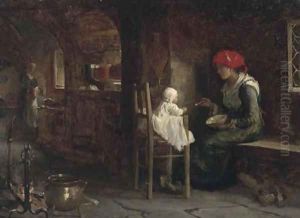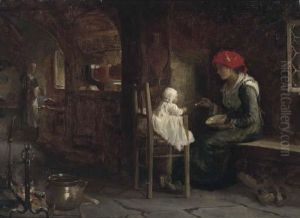William H. Jobbins Paintings
William H. Jobbins was an English glassmaker and stained glass designer, born in 1851 and passing away in 1921. His career spanned the latter half of the 19th century and the early years of the 20th century, a period marked by a revival of interest in Gothic and medieval styles in architecture and decorative arts, especially in Britain. Jobbins was part of this revival, contributing significantly to the field of stained glass, an art form that was experiencing a renaissance after centuries of decline.
Jobbins' work was characterized by its meticulous craftsmanship and the vibrant use of color, often incorporating themes from nature, religious iconography, and historical subjects. His designs were influenced by the broader Arts and Crafts movement, which emphasized the importance of craftsmanship and the beauty of handmade objects in reaction to the industrialization of the era. The movement sought to elevate the status of crafts to that of the fine arts, a principle that Jobbins’ work exemplified.
Though not as widely known as some of his contemporaries like William Morris or Charles Eamer Kempe, Jobbins contributed significantly to the stained glass projects of the time. His works adorned various churches and buildings across England, each piece reflecting his deep understanding of the medium and his ability to adapt to the stylistic demands of his clients while maintaining his artistic integrity. Despite the limited recognition during his lifetime and afterward, Jobbins' legacy endures through his surviving works, which continue to be studied and appreciated for their beauty and craftsmanship.
After his death in 1921, William H. Jobbins left behind a body of work that, while not extensive, is notable for its quality and the insight it provides into the stained glass revival of the Victorian era. Today, his creations remain a testament to the skill and artistry of glassmakers of his time, embodying the principles of the Arts and Crafts movement and the aesthetic values of the period in which he worked.


